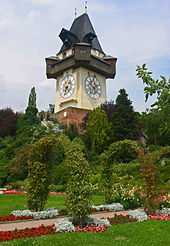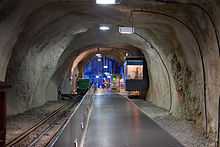Schloßberg (Graz)



The Schloßberg or Schlossberg (English: Castle Hill) is a tree-clad hill, and the site of a fortress, in the centre of the city of Graz, Austria. The hill is now a public park and enjoys extensive views of the city. It is the site of several entertainment venues, cafés and restaurants, and is managed by Holding Graz, the city owned utility company.[1][2]
The fortification of the Schloßberg goes back to at least the 10th century. In the mid-16th century, a 400 m (1,300 ft) long fortress was constructed by architects from the north of Italy. There are records of a cable-hauled lift being in use between 1528 and 1595 to move construction materials for the fortifications. The castle was never conquered, but it was largely demolished by Napoleonic forces under the Treaty of Schönbrunn of 1809. The clock tower (the Uhrturm) and bell tower (the Glockenturm) were spared after the people of Graz paid a ransom for their preservation.[1][2][3][4]
The remains of the castle were turned into a public park by Ludwig von Welden in 1839. The park contains the Uhrturm, the Glockenturm, a cistern (the Türkenbrunnen) and two bastions from the old castle. The Uhrturm is a recognisable icon for the city, and is unusual in that the clock's hands have opposite roles to the common notion, with the larger one marking hours while the smaller is for minutes. The Glockenturm contains Liesl, the heaviest bell in Graz.[1][2][5]
Near the Uhrturm there is a café with views over the old town. Additionally, on the western side of the Schloßberg, there are two small cafés, one with table service and the other one with self-service. Next to the terminus of the funicular railway there is a hilltop restaurant with views of western Graz. In what was once the cellar of one of the ruined bastions is the Kasemattenbühne, an open-air stage for concerts and performances.[6][7]
Below the Schloßberg hill is an extensive system of tunnels, which were created during the second world war to protect the civilian population of Graz from aerial bombing. Some of these tunnels are still accessible, including a passage from Schloßbergplatz to Karmeliterplatz, and a grotto railway for children. Also in the tunnel complex is the Dom im Berg, which was expanded in 2000 to provide a venue space for up to 600 people.[1]
The summit of the hill is linked to the city centre by various steep paths and staircases, and by the Schlossbergbahn, a funicular railway. Additionally the recent Schlossberg lift links the summit to the tunnel system and, via that, to Schloßbergplatz.[8][9]
Each year the Elevate Festival, a festival for contemporary music, art and political discourse, is held in various venues in and around the Schlossberg.
References
- ↑ 1.0 1.1 1.2 1.3 "Die Geschichte des Berges" [The history of the mountain] (in German). Holding Graz. Retrieved 2003-06-26.
- ↑ 2.0 2.1 2.2 "Schlossberg". Graz Tourism. Retrieved 2003-06-26.
- ↑ "Schloßbergbahn Graz". seilbahngeschichte.de (in German). Archived from the original on 2010-08-22. Retrieved 2003-06-26.
- ↑ Strobl, Alexander (8 July 2008). "A Short History of the City". Graz: Stadt Graz - Magistratsdirektion, Abteilung für Öffentlichkeitsarbeit. Retrieved 2 July 2013.
- ↑ "Grazer Uhrturm". Graz-Reise.de. Retrieved 2003-06-26.
- ↑ "Die Gastronomie am Schloßberg" (in German). Holding Graz. Retrieved 2003-06-26.
- ↑ "Die Kasemattenbühne" (in German). Holding Graz. Retrieved 2003-06-26.
- ↑ "Schloßbergbahn - Fahrspaß mit Panoramablick..." [Schloßbergbahn - fun with a panoramic view] (in German). Holding Graz. Retrieved 2003-06-26.
- ↑ "Schloßberglift" (in German). Holding Graz. Retrieved 2003-06-26.
External links
-
 Media related to Grazer Schloßberg at Wikimedia Commons
Media related to Grazer Schloßberg at Wikimedia Commons - Schloßberg page on Graz Tourism web site
- Schloßberg page on Holding Graz web site
Coordinates: 47°04′34″N 15°26′14″E / 47.07611°N 15.43722°E